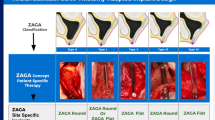Abstract
Esthesioneuroblastoma (ENB) involving the anterior skull base is a rare malignant tumour derived from the olfactory epithelium. The gold standard of surgical treatment is currently craniofacial resection (CFR), which allows efficient removal of the tumour but entails significant morbidity. To reduce morbidity combined with good visualization of tumour limits removal, endonasal endoscopy resection (EER) has developed. The objective of this work was (1) to describe the EER surgical procedure, the morbidity, and the limitations of this endoscopic approach as compared with CFR, (2) analyse recurrences to define risk factors of recurrences and (3) to discuss a therapeutic decision algorithm. Retrospective series of 18 patients with ENB endoscopically treated in a university tertiary referral centre over 13 years. Fifteen of those underwent radiotherapy. Epidemiological data, clinical and imaging findings, histology, treatment modalities and outcome of patients were studied. Mean follow-up was 31 months. Morbidity was mainly related to radiotherapy. Three recurrences were detected: one bone and one sylvian metastasis, and a local recurrence in a patient not irradiated. One recurrence spread through leptomeningeal propagation. Dural extension and frontal invasion were significantly associated with recurrences (p = 0.001 and p = 0.019, respectively). Patients with dural extension or frontal invasion should receive aggressive treatment. With a low rate of perioperative morbidity and efficient local control, EER seems to be a promising approach for selected cases of ENB.


Similar content being viewed by others
References
Svane-Knudsen V, Jørgensen KE, Hansen O, Lindgren A, Marker P (1998) Cancer of the nasal cavity and paranasal sinuses: a series of 115 patients. Rhinology 36:12–14
Skarsgard DP, Groome PA, Mackillop WJ et al (2000) Cancers of the upper aerodigestive tract in Ontario, Canada, and the United States. Cancer 88:1728–1738
Berger L, Luc R, Richard D (1924) L’esthesioneuroepitheliome olfactif. Bull Assoc Fr Etude Cancer 13:410–421
Broich G, Pagliari A, Ottaviani F (1997) Esthesioneuroblastoma: a general review of the cases published since the discovery of the tumour in 1924. Anticancer Res 17:2683–2706
Chao KS, Kaplan C, Simpson JR et al (2001) Esthesioneuroblastoma: the impact of treatment modality. Head Neck 23:749–757
Patel SG, Singh B, Polluri A et al (2003) Craniofacial surgery for malignant skull base tumors: report of an international collaborative study. Cancer 98:1179–1187
Wang C-C, Chen Y-L, Hsu Y-S, Jung S-M, Hao S-P (2005) Transcranial resection of olfactory neuroblastoma. Skull Base 15:163–171 (discussion 171)
Morita A, Ebersold MJ, Olsen KD, Foote RL, Lewis JE, Quast LM (1993) Esthesioneuroblastoma: prognosis and management. Neurosurgery 32:706–714 (discussion 714–715)
Ganly I, Patel SG, Singh B et al (2005) Craniofacial resection for malignant paranasal sinus tumors: report of an International Collaborative Study. Head Neck 27:575–584
Devaiah AK, Andreoli MT (2009) Treatment of esthesioneuroblastoma: a 16-year meta-analysis of 361 patients. Laryngoscope 119:1412–1416
Lund VJ, Stammberger H, Nicolai P et al (2010) European position paper on endoscopic management of tumours of the nose, paranasal sinuses and skull base. Rhinol Suppl 22:1–143
Soler ZM, Smith TL (2012) Endoscopic versus open craniofacial resection of esthesioneuroblastoma: what is the evidence? Laryngoscope 122:244–245
Suarez C, Llorente JL, Fernandez De Leon R, Maseda E, Lopez A (2004) Prognostic factors in sinonasal tumors involving the anterior skull base. Head Neck 26:136–144
Hyams VJ (1988) Olfactory neuroblastoma. Tumours of the upper respiratory tract and ear. In: Hyams V, Batsakis J, Michaels L (eds). Armed Forces Institute of Pathology, Washington DC, pp 240–248
McElroy EA Jr, Buckner JC, Lewis JE (1998) Chemotherapy for advanced esthesioneuroblastoma: the Mayo Clinic experience. Neurosurgery 42:1023–1027 discussion 1027–1028
Dulguerov P, Calcaterra T (1992) Esthesioneuroblastoma: the UCLA experience 1970–1990. Laryngoscope 102:843–849
Kadish S, Goodman M, Wang CC (1976) Olfactory neuroblastoma. A clinical analysis of 17 cases. Cancer 37:1571–1576
Fitzek MM, Thornton AF, Varvares M et al (2002) Neuroendocrine tumors of the sinonasal tract. Results of a prospective study incorporating chemotherapy, surgery, and combined proton-photon radiotherapy. Cancer 94:2623–2634
Kim D-W, Jo Y-H, Kim JH et al (2004) Neoadjuvant etoposide, ifosfamide, and cisplatin for the treatment of olfactory neuroblastoma. Cancer 101:2257–2260
Draf W, Weber R (1993) Endonasal micro-endoscopic pansinusoperation in chronic sinusitis. I. Indications and operation technique. Am J Otolaryngol 14:394–398
Jethanamest D, Morris LG, Sikora AG, Kutler DI (2007) Esthesioneuroblastoma: a population-based analysis of survival and prognostic factors. Arch Otolaryngol Head Neck Surg 133:276–280
Bachar G, Goldstein DP, Shah M et al (2008) Esthesioneuroblastoma: the Princess Margaret Hospital experience. Head Neck 30:1607–1614
Cantù G, Solero CL, Miceli R et al (2005) Which classification for ethmoid malignant tumors involving the anterior skull base? Head Neck 27:224–231
Harrison D (1984) Surgical pathology of olfactory neuroblastoma. Head Neck Surg 7:60–64
Folbe A, Herzallah I, Duvvuri U et al (2009) Endoscopic endonasal resection of esthesioneuroblastoma: a multicenter study. Am J Rhinol Allergy 23:91–94
Gallia GL, Reh DD, Salmasi V, Blitz AM, Koch W, Ishii M (2011) Endonasal endoscopic resection of esthesioneuroblastoma: the Johns Hopkins Hospital experience and review of the literature. Neurosurg Rev 34:465–475
Song CM, Won T-B, Lee CH, Kim D-Y, Rhee C-S (2012) Treatment modalities and outcomes of olfactory neuroblastoma. Laryngoscope 122:2389–2395
Rimmer J, Lund VJ, Beale T, Wei WI, Howard D (2013) Olfactory neuroblastoma: A 35-year experience and suggested follow-up protocol. Laryngoscope. Epub ahead of print
Cusimano MD (1999) Quality-of-life assessment in patients with lesions of the cranial base. Skull Base Surg 9:259–264
Castelnuovo P, Lepera D, Turri-Zanoni M et al (2013) Quality of life following endoscopic endonasal resection of anterior skull base cancers. J Neurosurg 119:1401–1409
Conflict of interest
The authors declare that they have no conflicts of interest concerning this article.
Author information
Authors and Affiliations
Corresponding author
Rights and permissions
About this article
Cite this article
Montava, M., Verillaud, B., Kania, R. et al. Critical analysis of recurrences of esthesioneuroblastomas: can we prevent them?. Eur Arch Otorhinolaryngol 271, 3215–3222 (2014). https://doi.org/10.1007/s00405-014-3035-1
Received:
Accepted:
Published:
Issue Date:
DOI: https://doi.org/10.1007/s00405-014-3035-1




